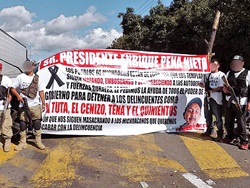Vigilantes in Michoacan, Mexico recently set up blockades in nine municipalities to protest government inaction and call for the dissolution of the state-mandated force created earlier this year, raising questions about why they have chosen to reassert themselves now after several months of relative quiet.
On December 14, around 800 people placed vehicles, buses and trucks in the roads in various parts of Michoacan state to block traffic, reported Excelsior. In at least one municipality, officials reported the presence of armed men.
Members of the Rural Defense Force — a group of vigilantes formalized by the government earlier this year — burned their uniforms during the protest, reported Terra. According to media, various protesters wore white t-shirts that read “Vigilante Groups” and called for an end to the Rural Defense Force, said Reuters.
One sign held by the protesters read:
“The people of Michoacan are in mourning because the Templars [a reference to the Knights Templar criminal organization] keep killing, ambushing and disappearing vigilantes and rural forces. We are asking for all of your government’s help to detain the criminals.”
Others claimed that if the government were to take action, they could arrest all of the “criminals” affecting Michoacan in just two weeks, reported Reuters.
The blockades were taken down by early evening on the same day, reported Excelsior.
InSight Crime Analysis
Various media have reported the blockades as a “return” or “resurgence” of the vigilante groups that initially emerged in Michoacan with the stated purpose of combatting criminal groups — and particularly the Knights Templar — in that state. Since the government created the Rural Defense Force in May, as part of a January agreement that provided vigilantes with some measure of legitimacy in their operations, news regarding their activities has slowed.
Voices of discontent have continued to emerge, with the arrest of vigilante leader Jose Manuel Mireles in June sparking a wave of protests, while a Rural Defense Force leader was murdered just weeks after claiming the government was failing to adequately support the force’s members.
SEE ALSO: Coverage of Mexico Vigilantes
The reemergence of the vigilantes now — and their apparent rejection of the government-supported force — could be linked to a current generalized atmosphere of insecurity and distrust of the Mexican government. In neighboring Guerrero, the September disappearances of 43 student protesters, who may have been murdered on the orders of a local mayor, has provoked widespread unrest, which may be spilling over.
Regardless of the motive, the idea that the vigilantes are back to staging protests and denouncing the government is sure to be of concern for the administration of President Enrique Peña Nieto, which has had difficulty keeping the movement under control. Furthermore, with some elements of the self-defense forces thought to have criminal ties — something recently highlighted by Michoacan’s security commissioner, who warned against giving amnesty to vigilantes — things could quickly get out of hand.

